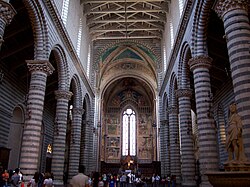
Back Gòtic italià Catalan Gotická architektura v Itálii Czech Arquitectura gótica en Italia Spanish Gotico italiano Italian Италијанска готска архитектура Macedonian Architektura gotycka we Włoszech Polish Arquitetura gótica na Itália Portuguese Italijanska gotska arhitektura Slovenian สถาปัตยกรรมกอทิกแบบอิตาลี Thai
| Years active | 12th to 15th century |
|---|---|
| Location | Italy |
Italian Gothic (also described and defined as "temperate" Gothic) has characteristics that distinguish it considerably from that of the place of origin of Gothic architecture, namely France, and from other European countries in which this language has spread (Great Brittany, Germany, Spain).[1]
Italian architects preferred to keep the traditional construction methods established in the previous centuries; architectural solutions and technical innovations of French Gothic were seldom used. Soaring height was less important than in Northern Europe. Brick rather than stone was in many areas the most common building material, and marble was widely used for decoration.[2] In the 15th century, when the Gothic style dominated both Northern Europe and the Italian Peninsula, Northern Italy became the birthplace of Renaissance architecture.[1]
- ^ a b Watkin 1986, pp. 166–67.
- ^ Encyclopaedia Britannica, "Western Architecture, Italian Gothic" (retrieved August 28, 2020)


